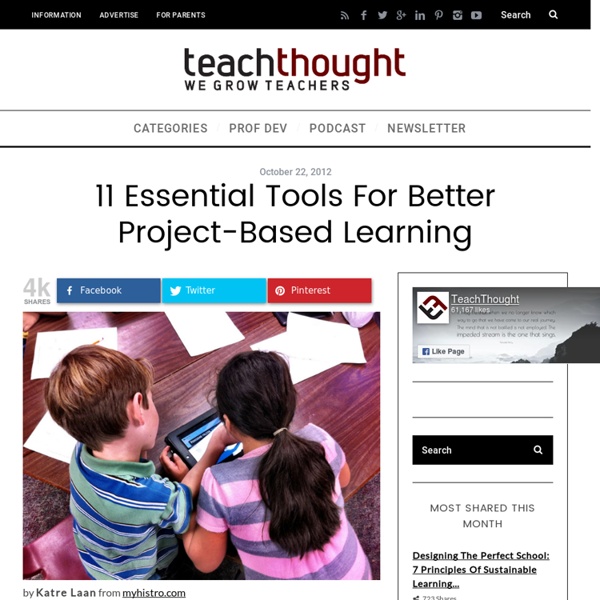PDF to Word Converter Online - PDFBurger.com – 100% FREE
How to convert PDF to Word online Updated: 24 July, 2016 Although we all know that virtually any document can be saved in or imported to the PDF format, few realize that the opposite is also possible with the right tool at hand. The process of PDF to Word conversion using Docs.Zone is really straightforward: Load Docs.Zone in your browser by typing in the address of the service in the address bar and pressing Enter: to the "PDF to Word" tab.Click the "Select files..." button, navigate to the necessary folder and select the file you need to convert.If necessary, you can add any number of files to the conversion job by clicking the "Add files" button.Once you are done selecting files, click "Start!" As you see, converting PDF to Word online is extremely easy.
The Difference Between Projects And Project-Based Learning
The Difference Between Projects And Project-Based Learning by TeachThought Staff Projects in the classroom are as old as the classroom itself. “Projects” can represent a range of tasks that can be done at home or in the classroom, by parents or groups of students, quickly or over time. The learning process is also personalized in a progressive PBL environment by students asking important questions, and making changes to products and ideas based on individual and collective response to those questions. By design, PBL is learner-centered. The chart below by Amy Mayer is helpful to clarify that important difference between projects and project-based learning. What’s the Difference Between “Doing Projects” and Project Based Learning ?
Homemade Advent wreath
Here’s how to make a homemade Advent wreath, for a candle-lit countdown to Christmas. Homemade Advent wreath Advent marks the four weeks leading up to the celebration of Christmas. There are five candles on an Advent ring, and the tradition is to light each one in turn on the Sundays that run up to Christmas, lighting the central fifth one on Christmas Eve or Christmas Day itself. Religious or not, the Advent wreath can be a great focus for some calm in this busy season. We used a salt dough recipe to make our candle holders. two cups flour two cups salt and one cup water Then you can mould the dough into any shape you like ~ the dough makes great Christmas tree decorations. Then you need to place the candle holders on a baking tray and bake at Gas 1/2, 120C, 250F for about 3 hours. While you’re waiting for the candle holders to bake, you can make the Advent wreath. Then we glues our circles down on a piece of thick card, to give us a decorative base for our Advent wreath.
23 Ways To Use The iPad In The 21st Century PBL Classroom By Workflow
23 Ways To Use The iPad In The 21st Century PBL Classroom by TeachThought Staff The iPad is not magic, and as many educators have found integrating them meaningfully is by no means a just-add-water proposition. The same applies to Project-Based Learning. Project-Based Learning is a method of giving learners access to curriculum in authentic ways that promote collaboration, design, imagination, and innovation while also allowing for more natural integration of digital and social media. Note that the visual is also arranged in a kind of visual spectrum, as our past visuals have been.
Flashcards about sobiranje
incorrect cards (0) correct cards (0) remaining cards (11) Save retry fix restart shuffle help To flip the current card, click it or press the Spacebar key. retry the cards in the incorrect box restart all cards Embed Code - If you would like this activity on your web page, copy the script below and paste it into your web page.
11 Steps Of Effective Project-Based Learning In A Blended Classroom -
In part 1 of this 6-part series, Thomas Stanley looked at an overview of blended learning, specifically the critical interactions of a blended learning model. In part 2, he looked specifically at student-to-student interaction, and the reality of synchronous and asynchronous access. In part 3, he looked at student-to-teacher interactions, and moving from instruction to becoming the “guide on the side,” and in part 4 he explored the idea of student-to-community interactions. Below in part 5, Stanley examines Student-to-material interactions as part of the blended learning model, specifically the process of project-based learning in a blended classroom. Student-to-Material Interaction: Effective PBL Learning in the Online or Blended Classroom What is the most effective way to get students to grapple with the subject matter? The projects should be designed to meet state and local standards. Implementing The Project-Based Learning Approach Step 1 Step 2 Step 3 Step 4 Step 5 Step 6 Step 7 Step 8
Beautiful web-based timeline software
How 21st Century Thinking Is Different
How 21st Century Thinking Is Just Different by Terry Heick This content is proudly sponsored by The Institute for the Habits of Mind, promoting the development of personal thinking habits in 21st century learners. In an era dominated by constant information and the desire to be social, should the tone of thinking for students be different? After all, this is the world of Google. As a result, the tone of thinking can end up uncertain or whimsical, timid or arrogant, sycophant or idolizing–and so, devoid of connections and interdependence. The nature of social media rests on identity as much as anything else—forcing subjectivity on everything through likes, retweets, shares, and pins. But this takes new habits. Information Abundance There is more information available to any student with a smartphone than an entire empire would have had access to three thousand years ago. New contexts—digital environments that function as humanity-in-your-pocket—demand new approaches and new habits. Persisting.
Timeline Maker
Teacher Resources



